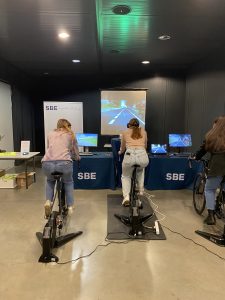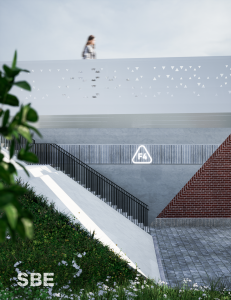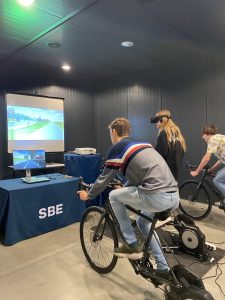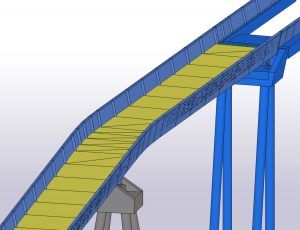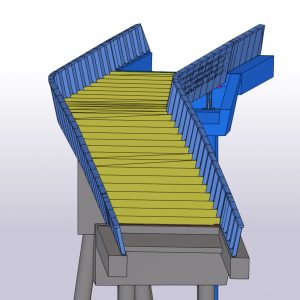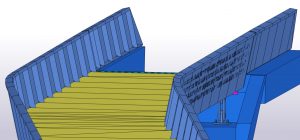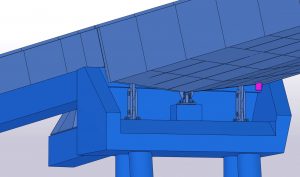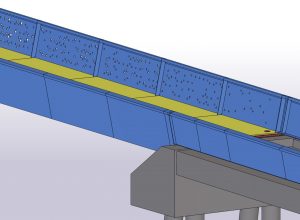 Vítěz kategorie v zemích:
Vítěz kategorie v zemích:
Fietsbrug Vijfstraten

| Kategorie | Projekty infrastruktury |
|---|---|
| Rok | 2022 |
| Země | Benelux |
| Organizace | SBE nv |
| Partneři projektu | SBE |
| Autor | SBE |
| Spoluautoři | BIM-team, Team Ruimte, Team engineering, Team Infra |
| Klient | Provincie Oost-Vlaanderen |
| Místo stavby | Sint-Niklaas |
| Tags |
Projectomschrijving
Overal in Vlaanderen wordt fors geïnvesteerd in nieuwe fietssnelwegen. Voor de aanleg van de fietssnelweg F4 tussen Gent en Antwerpen zorgt het huidige traject ter hoogte van Sint-Niklaas voor een onveilige situatie voor de zwakke weggebruiker. Het traject wordt daarom aangepast zodat dit parallel loopt met de spoorlijn, met een ongelijkgrondse kruising ter hoogte van Vijfstraten en een gelijkvloerse kruising ter hoogte van de Nieuwe Molenstraat. SBE wordt dankzij zijn geïntegreerde aanpak gekozen om in dit dossier de totale ontwerpstudie op zich te nemen.
Het voorgestelde tracé is een quasi rechte, bovengrondse verbinding die de fietser een optimaal comfort garandeert. Verschillende varianten werden uitgewerkt met aandacht voor dit fietscomfort, maar ook doorstroming, fietsveiligheid, ruimtelijke impact, leesbaarheid en timing/uitvoerbaarheid.
In het ontwerp voor de fietsbrug wordt gestreefd naar een elegante, slanke constructie, die de overspanning van 93 meter in een vloeiende, comfortabele beweging maakt. Het is hier dat architecturaal en technisch ontwerp hand in hand gaan. De stalen brug wordt opgevat als een enkel U-vormig profiel met een continue dwarssectie. Elk architecturaal onderdeel wordt ook ingezet om stabiel-technisch een meerwaarde te zijn. De borstweringen worden bijvoorbeeld op decoratieve wijze geperforeerd of gelasercut, rekening houdend met het krachtenverloop. Om de wenselijke slankheid te bekomen en de vrije hoogte onder de brug te maximaliseren wordt een elegante pijler voorzien na de overspanning van 60m over Vijfstraten.
Het traject bevindt zich binnen een dens stedelijk weefsel naast een spoorwegtalud. Waar mogelijk wordt daarom een natuurlijk talud voorzien, begroeid met streekeigen halfhoge struikachtige gewassen, dat dienst kan doen als een groene ader tussen het verder harde landschap. Enkel op plaatsen waar dit wegens ruimtegebrek niet mogelijk of wenselijk is, wordt het natuurlijk talud vervangen door een grondkering. Deze grondkering wordt als groen element uitgewerkt op basis van gewapende grond met geogrids en geocellen. Dit heeft diverse voordelen. De meest voor de hand liggende is het doortrekken van de lijn van groene taluds in deze grondkeringen, zodat voor de naburige percelen er een verderzetting van het landschap is. Er is verder ook geen gevaar voor schade aan de bestaande keermuur ten gevolge van trillingen bij de constructie. De nodige controles tijdens de werken inzake eventuele zettingen aan het spoor worden in samenspraak met Infrabel uitgevoerd.
Aanpak
De brug is parametrisch ontworpen met behulp van de softwareprogramma’s Rhino 6 & Grasshopper. Dit model is gekoppeld aan het rekenmodel van SOFiSTiK maar ook aan Tekla, Revit en Civil 3D.
De ontworpen toestand, het tracé van de brug én het 3D alignement is getekend in Civil 3D. Deze data is gebruikt in Rhino 6 en Grasshopper om hierrond de andere geometrie op te bouwen. Deze geometrie en data is hierna gebruikt in het rekenmodel in SOFiSTiK, maar ook in Tekla om de stalen brug en bekisting te genereren. Door te werken met 1 centraal model kunnen er heel snel aanpassingen gebeuren in het ontwerp.
Door dit project volledig in 3D uit te werken en het gebruiken van de geschikte data, is het van bij de aanbestedingsfase heel eenvoudig om hoeveelheden aan materiaal op te vragen. Het stelt ons ook in staat om deze modellen te gebruiken als bron voor onze visualisaties en deze zijn tevens de basis voor ons complete BIM-model. Tijdens het hele ontwerp stond werken volgens de BIM-methodiek centraal. Hergebruik van modellen en data, centrale bron van informatie & communicatie, dit zijn de essentiële zaken die dit project gesteund hebben.
Wat was nu de volgende stap?
Wat maakt het project Fietsbrug Vijfstraten net zo speciaal? Wat was onze ambitie om die “extra mile” te bereiken?
Wel, we kregen de vraag om de buurtbewoners en stakeholders mee te nemen in ons verhaal en het toekomstige ontwerp zo goed mogelijk te laten beleven. Vaak gebruiken we daar 4D animaties & 3D visualisaties voor, die heel duidelijk aantonen wat de impact is op de huidige omgeving. Bij de fietsbrug Vijfstraten wouden we aan die beleving een extra dimensie toevoegen, namelijk; De buurtbewoners & stakeholders in het ontwerp laten rondfietsen, virtueel dan toch. Het gehele BIM-model is gekoppeld aan onze eigen ontwikkelde fietssimulator. Op de fietssimulator fietst men virtueel over de toekomstige fietsbrug en doordat we de data van het BIM-model hieraan gekoppeld hebben, voelt men de correcte weerstand van het ontworpen tracé. Men heeft hierbij ook de mogelijkheid om tijdens het fietsen rond te kijken in de omgeving door gebruik te maken van een VR-headset. Het gehele BIM-model is geoptimaliseerd naar een Visualisatie-model en we hebben binnen een bepaalde straal rond het project de nodige aandacht besteed aan de huidige omgeving en inplanting van het project zodat dit ook voor iedereen herkenbaar is.
Project description
Everywhere in Flanders, substantial investments are being made in new cycle highways. For the construction of the F4 cycle highway between Ghent and Antwerp, the current section near Sint-Niklaas creates an unsafe situation for soft road users. The route will therefore be adapted so that it runs parallel to the railway line, with a grade-separated junction at Vijfstraten and a level junction at Nieuwe Molenstraat. Thanks to its integrated approach, SBE has been chosen to take on the entire design study.
The proposed route is an almost straight, above-ground connection that guarantees optimal comfort for the cyclist. Different variants have been developed in respect of cycling comfort, as well as flow, cycling safety, spatial impact, legibility and timing/feasibility.
The design for the cycle bridge strives for an elegant, slender construction, which turns the span of 93 metres into a flowing, comfortable movement. This is where architectural and technical design go hand in hand. The steel bridge is designed as a single U-shaped profile with a continuous transverse section. Each architectural component is also used to provide added value in terms of stability. For example, the parapets have decorative perforations or are laser-cut, taking into account the forces at work. In order to achieve the desired slenderness and to maximise the free height under the bridge, an elegant pillar is provided after the span of 60m over Vijfstraten.
The section is located within dense urban surroundings next to a railway embankment. Wherever possible, a natural embankment is therefore provided; overgrown with local partly shrub-like plants, it serves as a green vein in the otherwise harsh landscape. Only in places where this is not possible or desirable due to lack of space, will a natural embankment be replaced by a supporting foundation. This supporting foundation will be developed as a green element based on reinforced soil and the use of geogrids and geocells. This has several advantages. The most obvious is to continue the line of green embankments in these supporting foundations, so that for the neighbouring plots there is a continuation of the landscape. There is also no risk of damage to the existing retaining wall as a result of vibrations during construction. Any necessary checks during work in respect of possible items on the track are carried out in consultation with Infrabel.
Approach
The entire bridge has been drawn and calculated by various engineers and BIM designers. The bridge is parametrically designed using the software programs Rhino 6 & Grasshopper. This model is linked to the SOFiSTiK calculation model, but also to Tekla, Revit and Civil 3D.
The new design and the 3D alignment has been drawn in Civil 3D. This data was used in Rhino 6 and Grasshopper to build the other geometry around it. This geometry and data was then used in the calculation model in SOFiSTiK, but also in Tekla to generate the steel bridge and formwork. By working with 1 central model, adjustments can be made to the design very quickly.
By working out this project completely in 3D and using the appropriate data, it is very easy to request quantities of material from the tendering phase. It also allows us to use these models as a source for our visualizations and they are also the basis for our complete BIM model. Working according to the BIM method was central throughout the design. Reuse of models and data, central source of information & communication, these are the essential things that have supported this project.
The next step
What makes the Vijfstraten bicycle bridge project so special? What was our ambition to go that “extra mile”?
Well, we were asked to take the local residents and stakeholders into our story and let them experience the future design in the best possible way. We often use 4D animations & 3D visualisations for this, which clearly shows the impact on the current environment. For the bicycle bridge Vijfstraten we wanted to add an extra dimension to that experience; let the local residents & stakeholders cycle around in the design, virtually. The entire BIM model is linked to our own developed bicycle simulator. On the bicycle simulator somebody virtually cycles over the future bicycle bridge and because we have linked the data from the BIM model to it, they feel the correct resistance of the designed route. They also have the possibility to look around in the environment while cycling by using a VR headset. The entire BIM model has been optimised into a visualisation model and we have paid the necessary attention to the current surroundings and implantation of the project within a certain radius around the project so that this is also recognisable for everyone.
 Vítěz kategorie v zemích:
Vítěz kategorie v zemích:
